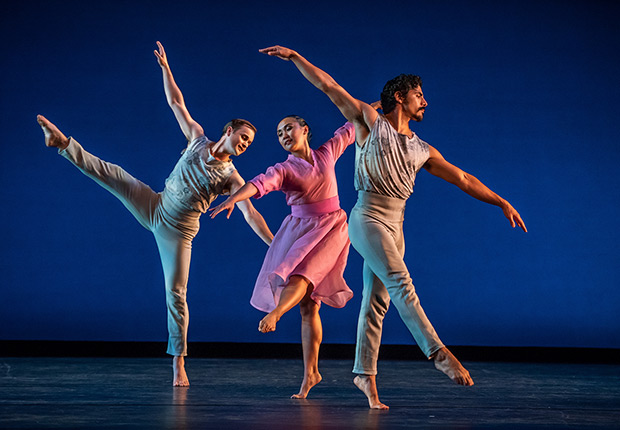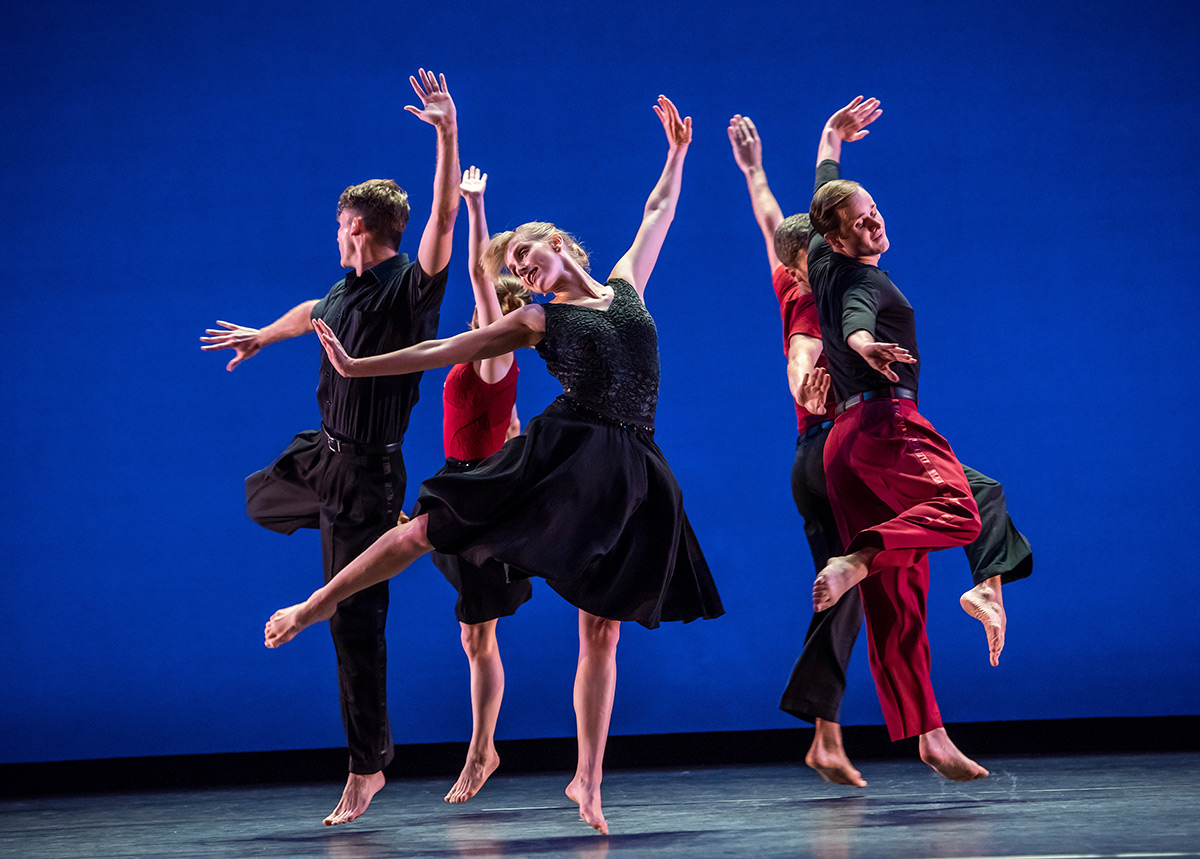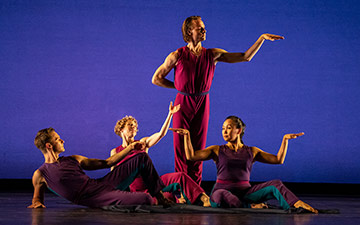
© Stephanie Berger. (Click image for larger version)
Mark Morris Dance Group
Love Song Waltzes, I Don’t Want to Love, The Trout
★★★✰✰
New York, Rose Theater
11 August 2018
markmorrisdancegroup.org
www.lincolncenter.org
Love’s Labours
Despite being part of Lincoln Center’s “Mostly Mozart” festival, not a bar of the Austrian composer’s music was heard in the programming at Mark Morris Dance Group (MMDG).
Instead a program of song-driven music made up the night’s repertoire, starting with 1989’s Love Song Waltzes set to Brahms’ Liebeslieder-Walzer (Op. 52), followed by melancholic, impassioned Monteverdi madrigals in I Don’t Want to Love (from 1996) and the near world premiere (it debuted Friday night) of The Trout, set to Schubert’s famed quintet which takes its name and theme from the composer’s highly hummable lieder, “Die Forelle.” Members of MMDG’s Music Ensemble provided the live accompaniment, with the addition of members of the Ariel Quartet.

© Stephanie Berger. (Click image for larger version)
Love Song Waltzes opens with pendulous, horizontal spirals but this initial sense of freedom is fleeting. Dancers move as if trapped and trying to break free, taking slightly off-kilter, statuesque poses, as if a remnant of a power-posturing eastern bloc statue. The lyrics for the opening song do speak to a certain self-imposed entrapment, (“Will you lock yourself up and throw away the key?”). By nature of the music, which is as sweet and singable as it is fraught, angular and expressionistic, Love Song has a vaguely bipolar quality. Dancers do waltz in Love Song, but they also hurl their bodies violently across the stage, chests bursting outward in terrifying, gasp-inducing moments of explosive energy. Couples lock and unlock, softness broken in certain moments, as when men in coupled pairings drop to the floor with a solid thud, their women hovering over them before picking them up. Love has many of the same trials as a toddler learning to walk: its environment hasn’t changed, but its capacity to interact with it increases, thus changing a formerly static, observational existence into something dynamic and increasingly unpredictable. Romance alters the lens through which people see the world and the sense of place in it, whether for better or for worse, and something about Love Song Waltzes communicates the organic cohesiveness of coupling and its flip side, the jarring uncertainty of love.
Monteverdi’s madrigals are highly praised, and when you see performances like this, the music alone is reason enough to buy a ticket. Members of MMDG perform on a mixture of period and modern reproductions instruments, including a theorbo, harpsichord, cello, and lute/guitar. I Don’t Want to Love sets seven of Monteverdi’s songs to dance, and the all-white, frayed, costumes by Isaac Mizrahi (they range from near-indecent hot pants to lengthy, Hellenistic gowns, satin robes and pajamas) give the impression that a shipwreck has just occurred, and a louche orgy may soon follow.

© Stephanie Berger. (Click image for larger version)
“Here I am, Ready for Kisses,” is a humorous number, with several dancers vying for affection from the dashing and moustachioed Domingo Estrada Jr., but the following song, “Lament of the Nymph,” is far more taxing. Lesley Garrison, who had been so wistful and sweet in Love Song Waltzes is here an angst-ridden powerhouse. With singing by soprano Jolle Greenleaf (who on this night slid into and out of pitches with a rather pop-like sensibility), this tune is an extreme call for help (“Send back my lover, as he once was; or kill me, so that I may no longer torment myself”). The vocals are haunting, and the breadth of emotional scope bewildering. The dissonance and unpredictable rhythms are uneasy, almost volatile, lending a spoken word effect. Monteverdi is celebrated for being ahead of his time, and this particular song is a striking reminder of that fact, almost to the point of distraction. Garrison fights herself, her gestures gigantic, and after an exacerbating solo she ends facing us, arched backwards, the slit up the front of her gown arriving at the apex of her thighs, her ribs expanding and contracting in overdrive, the dichotomy of weakness and strength found in love and its discontents, personified.
Like Balanchine, music is a priority for Morris. He gives us a healthy dose of appreciation in the introduction to Trout, which opens with lighting so dark as to render the stage almost invisible. Dancers walk then run offstage in that vague, yet purposeful way Morris dancers do so well. While the pedestrian movement is dance, it is equally non-dance, and enough to let the music dominate. By virtue of Morris’ opening statement — the men in neutral greys, the women in colorful soft belted chiffon dresses — combined with the plaintive melodies, it is clear that this is a pastoral, a dreamy saunter through Schubert.

© Stephanie Berger. (Click image for larger version)
The one dancer who does dominate is Laurel Lynch, who gives a heroic performance in Trout, for which she is onstage nearly the entire time. Her statuesque frame dwarfs some of the men but it’s no matter, in the petit allegros she is miraculously light and compact, and in the adagios and andantes, she unfolds herself in moments of astonishing beauty, as in her renversé or when she dives into a luscious arabesque penchée, partnering Dallas McMurray by leaning into him from behind. How striking Morris’ dancers are, how diversified in form and unique in expression and cohesive as a troupe — ever present and responsive to each other. The effervescent distribution of dancers continues throughout the piece, with bodies coming and going like so many bubbles evaporating.
here is an odd disturbance in the final movement, the dancers suddenly under attack, clutching their bodies or, in one case, hurling imaginary grenades. The pastoral atmosphere has been well and truly broken, until dancers resurrect, like football players feigning injury, then fly around, arms outstretched and noses diving, like children pretending to be aeroplanes. Women drift across the stage carried on men’s shoulders, and order is restored before a folk-inflected petit allegro ends the work, with Noah Vinson playing “aeroplane” as his fellow dancers look on.

© Stephanie Berger. (Click image for larger version)
The Trout, as Morris’ latest premiere, probably garnered more anticipation than it deserved — and the belated interruption of a “war and peace” narrative didn’t fully gel. Not whimsical enough to be comic relief, nor potent enough to be a visualization of the score (like the storm in Beethoven’s sixth). At first watch, Trout doesn’t strike me as a Morris masterpiece, but this doesn’t bother me. It may improve with time and another viewing, or it might not. While on the one hand, a bonafide master should be held to a high standard, how challenging it must be as an established artist, year in and out, be expected to produce masterpieces. By sheer virtue of how creativity works, and what audiences are ready for at any given time, even the best artists will have few “great” works to their name. Morris already has many, and I don’t expect every new work to blow me away. That said, as someone issued press tickets close to the stage, I know I didn’t “see” all of it. With artists like Taylor or Morris, both masters of migration and flow of bodies, the big picture is key, and sitting away from the stage shows the broader scope of the ebb and flow of formations. Maybe next time the answer will be unlocked in the cheap seats.

















You must be logged in to post a comment.